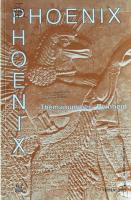
Academic Bio
When exploring the grammars of extinct but textually preserved languages, such as the languages of 2nd and 1st millennium BC Anatolia (modern Turkey), philology and linguistics need to go hand in hand. I define my field as linguistic Hittitology, rather than Hittitological linguistics, in that I use linguistic analysis to gain a better understanding of the interactions of text and society. My teaching and writing therefore operates at the intersection of linguistics, close reading of texts, and cultural analysis of the societies in which these texts functioned. My linguistic research interests cover several interrelated fields of linguistics from a functional and typological perspective: syntactic alignment, discourse cohesion, information structure and language change in contact situations. Several projects have been awarded fellowships from the Netherlands Organisation for Scientific Research, the Franke Institute of the Humanities, and the American Council of Learned Societies.
As one of the senior editors of the Chicago Hittite Dictionary Project I study the meaning of individual words. By contrast, my current book project Expressing Agency and Point of View: The Core Cases in the Ancient Anatolian Languages, 1700-300 BCE focuses on discovering how formal categories like the core cases (nominative, accusative, ergative, absolutive) create meaning beyond the dictionary definitions of individual words. Whereas the other cases all have been treated in monographs, the core cases have mainly been covered in articles or as part of larger overviews and grammars. With my project I intend to fill this gap in the linguistic description of not only Hittite but of all Indo-European Anatolian languages. Among the topics that the individual chapters will cover are the rise of ergativity in Hittite and Lycian, the semantics of noun classes, and voice alternations. Since the study is based on more than 1000 years of textual evidence, I will also investigate whether any observed language change correlates with known changes in society, such as population movements or extensive contact with other cultures. This intersects with my work on cultures and languages in contact.
My cultural studies result from the necessary close reading of texts and the need to understand these texts in context. I have, for example, approached the Hittites’ understanding of images through a semiotic lens, and investigated (and rejected) the artificial distinction between official religion and popular religion.
Another enduring interest is information structure, or the way special constructions, word order variation and function words like also, only and even highlight new, contrastive or unexpected information. I have explored this topic in a monograph and several articles. By developing a method for asking the text questions that go beyond lexical meaning I was able to prove a correlation between word order and contrast in Hittite. These results and my queries into the methodologies of grammatically describing ancient languages directly feed my recurring graduate seminar “Linguistic Methods for Extinct Languages”, where I have worked with students not only on the Anatolian languages but also on ancient Persian, Old French, Sumerian, Akkadian, Elamite, Biblical Hebrew, Quranic Arabic, Phoenician, extinct languages from the Amazon, ancient Egyptian, ancient Greek and Latin, and Chukchi.
I work with students with an interest in linguistics and literary analysis. I have advised theses and dissertations or have been a member of dissertation committees on meter, literary language, reflexivity, and the use of tense in Hittite; succession to the throne in the Old Hittite kingdom; Hittite warfare, religious administration, and ritual practice. I have also worked with students on literary techniques in Hebrew, contact-induced language change in Semitic, and linguistic variation in Ancient Egyptian. I am enthusiastic to work with students interested in semantic, syntactic, pragmatic and discourse studies of the Anatolian languages (Hittite, Luwian, and the minor languages), and languages in contact throughout the Ancient Near East.
Recent Public Talks
Recent Public Talks
Selected Publications
‘TÜRKMEN-KARAHÖYÜK 1: a new Hieroglyphic Luwian inscription from Great King Hartapu, son of Mursili, conqueror of Phrygia.’ With Theo van den Hout, James Osborne, Michele Massa, Christoph Bachhuber, Fatma Şahin. Anatolian Studies 70: 29-43.
‘The Packagers -ant- and -a-, and the Origin of Split-Ergativity in Hittite (and Lycian).’ In: David M. Goldstein, Stephanie W. Jamison, and Brent Vine (eds.), Proceedings of the 29th Annual UCLA Indo-European Conference. Bremen: Hempen 2018, 77–115.
‘Hittite Iconoclasm. Disconnecting the icon, disempowering the referent’. In Iconoclasm and Text Destruction in the Ancient Near East and Beyond, edited by Natalie Naomi May, Chicago 2012, 407-452
‘Focus Structure and Q-word Questions in Hittite.’ In Evelien Keizer and Mirjam van Staden (eds.), Interpersonal grammar: a cross-linguistic perspective. Thematic issue of Linguistics 47/4 (2009), 945-967
‘Central Anatolian languages and language communities in the Colony period: A Luwian-Hattian symbiosis and the independent Hittites.’ In Anatolia and the Jazira during the Old Assyrian period, edited by J.G. Dercksen, Leiden 2008, 137-180
Recent & Regularly Taught Courses
- AANL 10101-10102-10103 Elementary Hittite
- AANL 20126/30126 Literary Analysis of Hittite Texts
- AANL 20501/30501 Lycian
- AANL 30701 Linguistic Methods for Extinct Languages
- HUMA 17100 Language and the Human II





